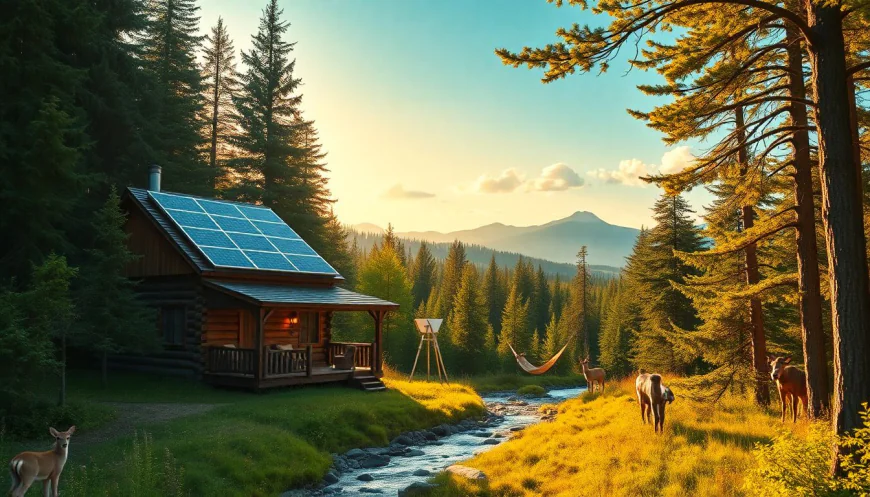Off-the-Grid Living: Embrace Sustainability, Freedom, and Self-Reliance
A growing number of people are seeking to live more sustainably and free from the constraints of modern society. Off-the-grid living is gaining popularity as a way to do just that. More folks want independence, lower bills, and a closer connection to nature. Recent stats show that off-grid homes are popping up everywhere, from mountain cabins to tiny eco-villages. Folks are motivated by the chance to reduce their carbon footprint, cut costs, and escape stress.

What Is Off-the-Grid Living?
Defining Off-the-Grid Living
Living off the grid means using no public water, power, sewer, or gas systems. It’s about being self-sufficient. Some choose tiny homes, others prefer cabins deep in the woods. Eco-friendly homes like earthships, made with recycled materials, have become popular too. The goal is independence from traditional utilities, relying instead on renewable sources and natural resources.
Common Motivations
Many want to cut their environmental impact by living sustainably. Others seek freedom from monthly bills and big cities’ noise. Self-reliance is a huge factor, along with the joy of supporting local food systems. Some also want a simpler life, disconnecting from constant notifications and stress.
Planning Your Off-the-Grid Lifestyle
Choosing the Right Location
Picking where to live off-grid takes some thought. Climate matters — hot, cold, dry, or wet? Water sources like lakes or wells are critical. Land laws and building rules also influence your choice. Some go for secluded mountain areas, while others find community eco-villages. Each location has its own pros and cons.
Securing Land and Property
Buying or leasing land is a key step. Look for plots with good water access and healthy soil. Ensure you understand local rules about building and renewable systems. It’s smart to hire a lawyer or expert familiar with land use laws. Planning ahead can save headaches later.
Designing an Off-the-Grid Home
Design matters for energy efficiency. Solar passive homes use natural sunlight for heat and light. Earthships are built with recycled tires and bottles, offering insulation and sustainability. Think about natural airflow, insulation, and materials that won’t harm the environment. The goal is to make your home work with nature, not against it.
Budgeting and Financing
Getting started costs vary. Setting up renewable power, water systems, and building materials can add up. But you can save by doing some work yourself. Financing options include personal loans, grants for green projects, or crowdfunding. Investing in off-grid living pays off in lower bills and a cleaner lifestyle.
Essential Off-the-Grid Systems and Technologies
Renewable Energy Solutions
Solar panels are the most common, providing electricity during the day. Wind turbines and small hydro setups work well if your location has wind or streams. Choose systems based on your needs and site conditions. Some homes aim for net-zero energy, producing as much as they use each year.
Water Management
Rainwater harvesting is popular on off-grid farms. Wells are reliable if you have access to underground water. Greywater systems recycle water from sinks and showers for irrigation. Purification methods like filters and UV lights ensure safe drinking water. Many communities use different water sources for various needs.
Waste Disposal and Sanitation
Composting toilets and greywater reuse cut waste and help gardens grow. Composting toilets don't need water, saving both water and space. Greywater systems redirect used water to plants instead of sewers. This creates a closed-loop system that’s more eco-friendly.
Food Production and Sustainability
Growing your own food reduces grocery bills and ensures fresh produce. Permaculture gardens mimic nature to maximize yields. Aquaponics combines fish tanks with plant beds, creating a sustainable food source. Preserving food through dehydration or fermentation also helps stockpile for winter months.
Daily Life and Self-Sufficiency
Skills Needed for Off-the-Grid Living
Basic skills like gardening, carpentry, and fixing renewable tech are essential. Learning how to maintain solar panels or build a rainwater system keeps everything running smoothly. Emergency preparedness, like first aid or knowing how to handle power outages, is important too.
Building a Community
Living off-grid isn’t always a solo act. Connecting with like-minded neighbors offers support, shared tools, and social connection. Community gardens or co-op grocery plans can make life easier. Sometimes, living close helps manage emergencies better.
Overcoming Challenges
Isolation can be tough, especially during winter or emergencies. Limited access to services might mean fast food or hospitals are far away. But with proper planning, backup plans, and technology, you can stay resilient. The rewards of independence often outweigh these hurdles.
Legal and Regulatory Considerations
Check local zoning laws and building codes before starting. Some areas require permits for renewable systems or water rights. Always research land use rules to avoid fines or project delays. Consulting experts or local authorities can smooth the process and ensure compliance.
Environmental Impact and Benefits
Living off-grid dramatically cuts carbon emissions. It lessens pollution, reduces strain on public resources, and helps protect ecosystems. If more people embrace this way of life, we can make a real difference in fighting climate change. The movement toward greener living grows stronger every year.
Future Trends in Off-the-Grid Living
New tech like smarter solar panels and battery storage makes off-grid life easier. Governments are offering incentives for renewable projects, encouraging more to make the switch. Society is starting to see off-the-grid living as a viable, even mainstream, choice for a sustainable future.
Conclusion
Off-the-grid living offers a way to live more sustainably, free, and self-reliant. Planning carefully, embracing renewable systems, and building community can lead to a rich, independent life. If you’re thinking about it, start by researching your area's rules and your motivations. The journey to off-grid living begins with a single step — are you ready?



 VARSHITHA
VARSHITHA